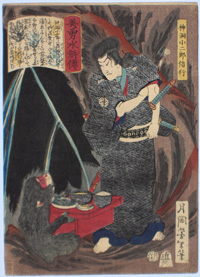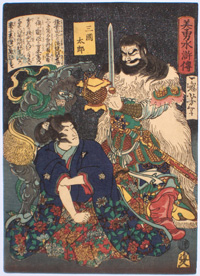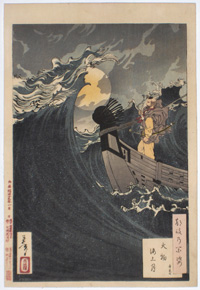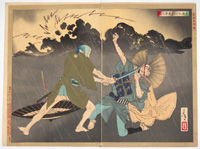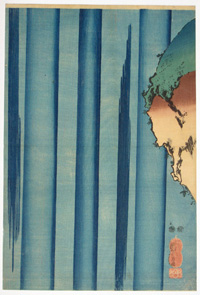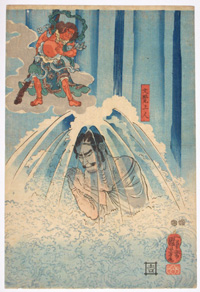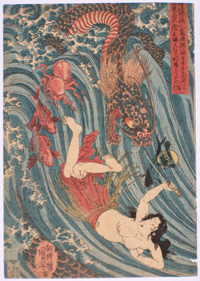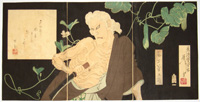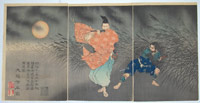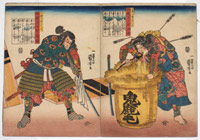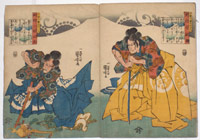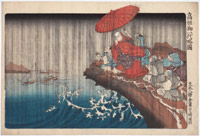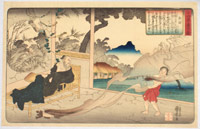Tsukioka YOSHITOSHI (1839 – 1892)
Click here to view image full size.
Shows the robber-chief Shindo Kojiro Nobuyuki being asked by the monkey spirit of Shinohaza to avenge his murder by Inaba Taro. From the fine chuban set of fifty prints Biyu Suikoden, “Handsome Heroes of the Water Margin” published by Omiya Kyujiro, 1866/7 ( this being 1867 ).
Fine impression and colour with strong burnishing. Very good condition. Signed Ikkaisai Yoshitoshi hitsu.
Status: Sold
Tsukioka YOSHITOSHI (1839 – 1892)
Click here to view image full size.
Shows Kinezumi Konoshi Kaiden, the muscular monk, killing a monstrous wild cat that had tormented a village. From the fine chuban set of fifty prints Biyu Suikoden, “Handsome Heroes of the Water Margin” published by Omiya Kyujiro, 1866/7 ( this being 1866 ).
Fine impression and colour. Very good condition. Signed Ikkaisai Yoshitoshi hitsu.
Status: Sold
Tsukioka YOSHITOSHI (1839 – 1892)
Click here to view image full size.
Shows Sangoku Taro who travelled through India and China learning conjuring tricks. From the fine chuban set of fifty prints Biyu Suikoden, “Handsome Heroes of the Water Margin” published by Omiya Kyujiro, 1866/7 ( this being 1866 ).
Fine impression and colour with mica ground. Very good condition. Signed Ikkaisai Yoshitoshi hitsu.
Status: Sold
Tsukioka YOSHITOSHI (1839 – 1892)
Click here to view image full size.
Shows Satami Jirotaro Yoshishige collecting the head of his adversary Awa Katsegura that his faithful dog has retrieved. From the fine chuban set of fifty prints Biyu Suikoden, “Handsome Heroes of the Water Margin” published by Omiya Kyujiro, 1866/7.
Fine impression and colour with gauffrage on the dog and mica ground. Very good condition. Signed Ikkaisai Yoshitoshi hitsu.
Status: Sold
Tsukioka YOSHITOSHI (1839 – 1892)
Click here to view image full size.
The best design from the set Tsuki hyakushi, the “Hundred Phases of the Moon”. The set published between 1885 and 1892 ( this being 1886 ) by Akiyama Buemon. Shows Benkei, at the prow of the ship holding Yoshitsune, attempting to pacify the ghosts of the Taira warriors and hence calm the storm in Daimotsu Bay.
Very good impression and colour. Full margins with extensive mica. Offsetting visible au verso, otherwise very good condition. Signed Yoshitoshi.
Status: Sold
Taiso YOSHITOSHI (1839 – 1892)
Click here to view image full size.
The monkey battles Kinkaku Daio on a sea cliff from the rare set of eight prints: Tsuzoku Saiyuki, “A Modern Journey to the West.” Based on Wu Cheng’en’s ( 1500-1582 ) most famous novel, Journey to the West, which was translated and condensed by Arthur Waley and entitled Monkey. This is probably the finest design from this high quality set. Published by Fukuta, 10/1864 ( this design 2/1865 ).
Superb impression. Fine colour and condition. Signed Ikkaisai Yoshitoshi ga.
Status: Sold
Utagawa TOYOKUNI I (1769 – 1825)
Click here to view image full size.
A complete diptych showing Kagekiyo and Mihonoya no Shiro battling. This is an episode from the beginning of Chapter 5, “The Dropped Bow” in book 11 of the Heike Monogatari, “ Tales of the Heike.” This episode, which took place in 1184, has the Genji warrior Mihonoya no Shiro confronting the Heike Kagekiyo on the beach at Yashima. Published c 1815 by Yamamotoya Heikichi.
Fine impression and in exceptional condition. Fine colour with large borders left and top. Signed Toyokuni ga.
Status: Sold
Tsukioka YOSHITOSHI (1839 – 1892)
Click here to view image full size.
Lu Ta ( Lu Chi Shen ) demolishing the gate of the temple of the Five-Crested Mountain. A Chinese captain, he accidentally killed a man and to escape death he became a priest at the temple. The abbot cut his hair and renamed him Lu Chi Shen, “Lu of Deep Wisdom.” However, quickly disregarding priestly vows, he became violent again and drank heavily. Staggering back one night he shattered the temple gate fighting the huge wooden guardian figures. The abbot dimissed him and he reappears as one of the 108 heroes of the Suikoden. Published by Matsui 1887.
Very fine impression of the earliest state of the first edition with blind printing and burnishing. This design was reprinted by Hasegawa with seal in upper left margin “Reproduction not permitted” and lacking date. Also, the lovely pigment used to colour the torso of the guardian figure ( which oxidizes ) is replaced with an inferior colour . There are also intermediate printings between first and Hasegawa version. Fine colour. Fine condition with left margin intact: These vertical designs must have the left border uncut as it often contains publication information. Signed Yoshitoshi.
Status: Sold
Tsukioka YOSHITOSHI (1839 – 1892)
Click here to view image full size.
Sakata Kintoki asleep in Raiko’s chamber preparing to rid him of the monstrous spider. From Yoshitoshi manga, “Sketches by Yoshitoshi.” A fine set of seven diptychs published by Kobayashi 1885-86 ( this being 1886 ).
Very fine impression of the first edition; the spider’s web printed in silver and with burnishing. Fine colour and as originally published with no backing paper, with the margins completely untrimmed ( often cut in this set ), and plenty of space for joining. Signed Yoshitoshi ga.
Status: Sold
Tsukioka YOSHITOSHI (1839 – 1892)
Click here to view image full size.
Murai Choan murders his brother at the crossroads of Fudanotsuji from Shinsen azuma nishiki-e, “New Selection of Eastern Brocade Pictures.” Published 1885-9 by Tsunashima. Choan is a character in a Kabuki drama but there is no mention of him killing his brother – artistic license.
Very fine impression of the first edition ( with three-colour cartouche and yellow borders ). Fine colour and as originally published with no backing paper, with the margins completely untrimmed, and plenty of space for joining. Signed Yoshitoshi.
Status: Sold
Ichiyusai KUNIYOSHI (1797 – 1861)
Click here to view image full size.
A fine and very rare vertical triptych of Mongaku ( Endo Morito, c. 1120 – 1200 ) subjecting himself to three years penance as a Buddhist monk beneath the waterfall of Mount Nachi in Kii Province. Morito inflicted this punishment on himself because he had inadvertently cut off the head of Kesa Gozen, the wife of the palace guard Watanabe Wataru, with whom he was in love. At the top of the design is Fudo Myo-o, the guardian deity of waterfalls, and at the bottom and top right are Seitaka and Kongara ( doji of Fudo ). This subject lends itself to some wonderful designs: See this website for a rare horizontal triptych by Yoshitoshi , and there are many single sheets by various artists. The vertical triptych format is rare: It was more convenient to view prints in the horizontal and it was difficult to insert into albums, the top sheets having to be heavily trimmed to fit. ( This impression is as published – completely untrimmed. ) Published by Sumiyoshiya Masagoro, c. 1851. Ex B. W. Robinson collection. This impression illustrated in his book Kuniyoshi, The Warrior Prints, 1982, pl. 64 ( Robinson T253 ). Another example of the same state – ex Pulverer collection – is illustrated in Heroes and Ghosts, Robert Schaap, p. 1998, no. 87, p. 102.
Fine impression and colour. Minor creases, otherwise very good condition. Untrimmed with extra paper for the sheets to join. There are two states of the print: As here with an extra block printing the waves at base of fall, and without. Both are known as fine impressions, although the version without appears to be slightly earlier. Signed Ichiyusai Kuniyoshi ga.
Status: Sold
Tsukioka YOSHITOSHI (1832 – 1892)
Click here to view image full size.
Shows Uesugi no Terutora, best known as Kenshin, riding into battle through clouds of smoke from the set Yoshitoshi musha burui, “Yoshitoshi’s Courageous Warriors.” He is best known for his long standing conflict with Takeda Shingen. For a time the two champions met every year, the campaigns always ending indecisively. Published by Kobayashi Tetsujiro, 1883 ( reprinted by Tsunajima Kamekichi ). Probably the best design from this excellent set.
Very fine impression of the first edition with two small red seals in left margin, complete date, original publisher and three-colour cartouche. There are a number of later editions of this set. Very fine colour. Album backing, otherwise very good condition. Signed Taiso Yoshitoshi ga.
Status: Sold
Ichiyusai KUNIYOSHI (1797 – 1861)
Click here to view image full size.
The otokodate Goshaku Somegoro playing a bamboo flute ( shakuhachi ) from Kuniyoshi moyo shofuda tsuketari genkin otoko, ” Typical Types of Manly Fellows in Kuniyoshi’s Style.” A fine set of portraits of chivalrous commoners published by Ibaya Kyubei, 1845. This is the actual impression illustrated in Heroes and Ghosts, Robert Schaap, 1998, no. 59, p. 81.
Fine impression and colour. Minor trimming, otherwise very good condition. Signed Ichiyusai Kuniyoshi ga.
Status: Sold
Ichiyusai KUNIYOSHI (1797 – 1861)
Click here to view image full size.
A fine and rare print showing the diving girl escaping with the Dragon King’s jewel. There were a number of prints designed by Kuniyoshi of this subject which lends itself to fine compositions. She is being chased by the Dragon, fish and octopuses. Published 1844 by Tsutaya. The first issue of this print by Tsutaya was around 1838 – 41 ( with the censor seal printed in black ). However, this is one of the rare examples where the reissue was superior to the original: With gradation on the Dragon and better colouration in the water.
Very good impression and colour. Trimmed round and minor edge wormage. Signed Cho-o-ro Kuniyoshi ga.
Status: Sold
Tsukioka YOSHITOSHI (1839 – 1892)
Click here to view image full size.
Wakashima Gonemon diving into a whirlpool to retrieve the ancient dragon-headed bell; it’s position indicated by two beams of light. The water god was unwilling to part with the bell. The finest design from Azuma no nishiki ukiyo kodan, published by Masudaya 1867/11. Second edition without kiri seal.
Very good impression and colour. Trimmed slightly at bottom, otherwise very good condition. Signed Ikkaisai Yoshitoshi ga.
Status: Sold
Tsukioka YOSHITOSHI (1839 – 1892)
Click here to view image full size.
The old hag of Adachi Moor. A gruesome tale of a high-ranking woman who kills young children to supply their blood to the local lord who suffers from an unknown disease. She is usually shown in a gourd vine-clad hut wielding a large knife. This design shows the actor Onoe Kikugoro V as the old crone in a revival of the Mokuami play in 1890. Published 1890 by Akiyama Buemon.
Fine impression and colour. Minor edge creases, otherwise very good condition. Large margins for joining. Signed Okokkeidoju Yoshitoshi ga.
Status: Sold
Tsukioka YOSHITOSHI (1832 – 1892 )
Click here to view image full size.
Lady Yodo, Yodo no Kimi, from the fine set Ikkai zuihitsu, “Essays by Yoshitoshi.” Lady Yodo ( 1567 – 1615 ) , the concubine of Toyotomi Hideyoshi, was installed at Yodo castle to the south of Kyoto. She bore him a son, Hideyori, in 1598 but the same year Hideyoshi died and Tokugawa Ieyasu staked his claim for political power. Lady Yodo fled to Osaka castle with her child where they eventually committed suicide. She is shown surrounded by smoke from the fire which destroyed the castle. Published by Masadaya, 1872/3.
Fine impression. This is the first edition with red seals in right margin ( rather than black ) and a lightly printed background, rather than the dark ground of later editions. Fine colour. Very slight centre fold and minor edge soil, otherwise very good condition. Signed Ikkaisai Yoshitoshi hitsu.
Status: Sold
Tsukioka YOSHITOSHI (1832 – 1892 )
Click here to view image full size.
Kiyohime from the fine set Wakan hyaku monogatari. “One Hundred Ghost Stories of China and Japan.” This famous story set in A.D.928 tells of unrequited love. It inspired a number of Kabuki and No plays and relates how Kiyohime’s love for the monk Anchin, who lived in the Dojo-ji temple on the banks of the Hidaka river, was repulsed due to his monk’s vows. To escape her attentions he hid in the great temple bell which happened to be placed on the ground. Kiyohime, swimming across the flooded river, saw the bell and transformed herself into a dragon which beat the bell and destroyed it and Anchin. Kiyohime is shown emerging from the river. Published by Daikin, 1865. This impression is from the rare first deluxe edition, on thick hosho and with fine burnishing to depict the water streaming off Kiyohime, and other special effects. Later editions lack these subtleties.
Superb impression. Extensive burnishing to clouds, hair and water.Very fine colour ( with deluxe red ). Minor edge thinning but with large margins. Signed Ikkaisai Yoshitoshi ga.
Status: Sold
Tsukioka YOSHITOSHI (1832 – 1892)
Click here to view image full size.
Shows Uesugi no Terutora, best known as Kenshin, riding into battle through clouds of smoke from the set Yoshitoshi musha burui, “Yoshitoshi’s Courageous Warriors.” He is best known for his long standing conflict with Takeda Shingen. For a time the two champions met every year, the campaigns always ending indecisively. Published by Kobayashi Tetsujiro, 1883 ( reprinted by Tsunajima Kamekichi ). Probably the best design from this excellent set.
Very fine impression of the first edition with two small red seals in left margin, complete date, original publisher and three-colour cartouche. There are a number of later editions of this set. Very fine colour. Fine condition. Signed Taiso Yoshitoshi ga.
Status: Sold
Tsukioka YOSHITOSHI (1832 – 1892)
Click here to view image full size.
A triptych showing a massive exploding mine throwing bodies into the air. Title: Taiheiki Masakiyo nansen no zu, “Masakiyo’s Difficult Battle from the Taiheiki Chronicles.” Published 10/1866 by Yamajin. Although set in the fourteenth century, in fact this is a comment on the recent ( spring of 1866 ) campaign of the Tokugawa Shogun Iemochi. He had temporarily defeated the dissident Choshu samurai who had shelled the Shogun’s palace in Edo in 7/1864. Sato Masakiyo on horseback is probably meant to represent the famous general Kato Kiyomasa. One of Yoshitoshi’s great designs and a similar composition is used by him in several of his picture books.
Fine impression and colour. Slight vertical centre folds strengthened au verso, otherwise good condition. Signed Ikkaisai Yoshitoshi hitsu.
Status: Sold
Ichiyusai KUNIYOSHI (1797 – 1861)
Click here to view image full size.
Yorimasa’s retainer, Hayata Tadazumi, despatching the Nue with his sword amongst thunder and lightning. The Nue ( a composite beast, as big as a house with monkey’s head, back of badger, claws of tiger, scales of dragon and tail of snake ) was shot by the skilled archer Yorimasa on the roof of the Shishinden Palace. One of the finest designs from Honcho Suikoden goyu happyakunin no hitori, “Eight Hundred Heroes of our Country’s Suikoden, One by One.” Robinson S4.6. Published by Kagaya Kichiyemon, c. 1830.
Very good impression and colour. Full size. Slight edge soil. Signed Ichiyusai Kuniyoshi ga.
Status: Sold
Utagawa KUNIYOSHI (1797 – 1861)
Click here to view image full size.
Shoki, “The Demon Quellor.” The ghostly Chinese protector of the Emperor Ming Hwang. A favourite subject for the Japanese, he is usually shown beating off annoying oni. He is always depicted dressed in Chinese military attire with the characteristic Chinese hat with side streamers and holding a two-edged sword. Illustrated on the cover of Utagawa Kuniyoshi. An exhibition of the work of Utagawa Kuniyoshi based on the Bidwell Collection, Springfield Museum of Fine Arts, 1980, no. 164. Kuniyoshi designed two other Shoki oban prints. All are rare. Published by Kinshodo, c. 1848 – 53. Ex collection Felix Fricke, seal au verso.
Very good condition. The background is blind printed to imitate partially creped paper. Signed Ichiyusai Kuniyoshi.
Status: Sold
Ichiryusai HIROSHIGE (1797 – 1858)
Click here to view image full size.
Gishi katakiuchi no zu, “Revenge of the Loyal Retainers.” The ronin assemble before the castle of Ko no Moronao before their attack. Published 1846 by Aritaya Kiyo-e mon. Rare.
Very good impression and colour. Some edge soil. Signed Hiroshige ga.
Status: Sold
Ichiyusai KUNIYOSHI (1797 – 1861)
Click here to view image full size.
Sagino-ike Heikuro grappling with a huge serpent at the lake of Sayama, Tondabayashi, in the Province of Kawachi from Honcho Suikoden goyu happyakunin no hitori, the “Eight Hundred Heroes of our Country’s Suikoden, One by One.” Published 1830s by Kaga-ya Kichiyemon ( but this issued by Iba-ya Sensaburo a little later ). A wonderful design.
Very good impression and colour. Small restored wormhole, otherwise very good condition. Totally untrimmed with extra paper. Signed Ichiyusai Kuniyoshi ga.
Status: Sold
Kochoro KUNISADA (1786 – 1865)
Click here to view image full size.
Shoki, “The Demon Quellor.” The ghostly Chinese protector of the Emperor Ming Hwang. A favourite subject for the Japanese, he is usually shown beating off annoying oni. He is always depicted dressed in Chinese military attire with the characteristic Chinese hat with side streamers and holding a two-edged sword. Published c 1847-1852.
Very good impression and colour. The paper has a semi-chirimen surface. Some creasing and minor marks. Signed Ichiyosai Utagawa Toyokuni hitsu.
Status: Sold
Gountei SADAHIDE (1807-1873)
Click here to view image full size.
The young Benkei, Oniwaka Maru, “Young Devil Child”, fighting the giant carp in the waterfall of Bishamon gataki. A strong composition, the vivid red of Oniwaka Maru contrasting with the aizuri background. Published by Ibaya Sensaburo.
Fine impression. Burnishing on the scales of the carp. Fine colour. Trimmed to edge of the fan shape and laid onto Japanese paper. Small backed binding holes. Signed Gountei Sadahide ga.
Status: Sold
Ichiyusai KUNIYOSHI (1797 – 1861)
Click here to view image full size.
The grand wrestling match between Kawazo Saburo Sukeyasu ( right ) and Matano Goro Kagehisa. In the background can be seen the first Kamakura shogun Yoritomo and his entourage. The event took place at Akazawa mountain in 1176 and is probably the most famous sumo match, also giving rise to a new manoeuvre called the “Kawazu hold.” One of Kuniyoshi’s great triptychs; much sought after and rare. By luck the original preparatory drawing for this triptych has survived and is in the Rijksmuseum voor Volkenkunde, Leiden. See Heroes and Ghosts, Hotei publishing, 1998, no.156, p.148. Published 1858 by Maruya Kyushiro.
Fine, early impression. Fine colour. Minor edge damage expertly repaired, otherwise very good condition. Full size. Signed Ichiyusai Kuniyoshi ga.
Status: Sold
Tsukioka YOSHITOSHI (1832 – 1892)
Click here to view image full size.
The Heian courtier Fujiwara no Yasumasa playing the flute by moonlight. Based on a
painting Yoshitoshi exhibited at the Exhibition for the Advancement of Painting in the
autumn of 1882. The story relates that while Fujiwara no Yasumasa was playing on Ichihara Moor he was approached by the bandit Kidomaru who intended to kill him. Instead he was overcome by the beauty of the music and gave up his plan. Yoshitoshi’s painting was so well received, the subject was incorporated into a play with Ichikawa Danjuro IX playing Fujiwara no Yasumasa several months after the publication of the print. Published 1883 by Akiyama Buemon. Considered by cogniscenti to be Yoshitoshi’s finest design.
Superb impression of the utmost finesse. This appears to be the only illustrated example with the background clouds wiped from left to right. The “proof” impression in The Philadelphia Museum of Art is annotated “Please print the background colour this way” [ clouds wiped right to left ]. Fine colour. Minimal shaving bottom centre sheet and a slight discoloration on last sheet, otherwise fine condition with extra paper for joining. Signed Oju Taiso Yoshitoshi sha.
Status: Sold
Ichiyusai KUNIYOSHI (1797 – 1861)
Click here to view image full size.
Raiko and his retainers attacking the enormous reclining hulk Shuten-doji ( “Great Drunkard Boy” ) who is in a drunken stupor. Raiko eventually cuts off the monster’s head and returns in triumph to Kyoto. One of Kuniyosh’s best designs. Published c.1851-2 by Amatsu. Robinson T261. Rare.
Very good impression and colour. Minor marks and creasing but generally good condition. Signed Ichiyusai Kuniyoshi ga.
Status: Sold
Ichiyusai KUNIYOSHI (1797 – 1861)
Click here to view image full size.
The complete set of six chuban diptychs: Oguri ju-yushi no ichi-nin, “The Ten Brave
Retainers of Oguri, One by One.” Robinson S26. Published by Yawata-ya Sakujiro, c.1843. Rare complete.
Fine impressions and colour. Minor marks and soil. Each print signed Ichiyusai Kuniyoshi
ga.
Status: Sold
Ichiyusai KUNIYOSHI (1797 – 1861)
Click here to view image full size.
Nichiren struggling up a snow-covered mountain near Tsukahara on the Island of Sado. The best design from Koso goichidai ryakuza, the “Illustrated Abridged Biography of the Founder.” Published by Iseya Rihei, c 1831. Like many great landscapes, there exist different states which causes confusion over which is the earliest. The basic difference is that the design is known with and without a horizon line and that there is at least one impression where the uninked, blind-printed line can be seen in a raked light. It has been asserted that those impressions without are the earliest; however, it seems from this that the sumi block was probably cut initially with the line but the publishers quickly realised it looked aesthetically better without printing it, and it was subsequently removed. In any case, this is an extremely rare print and most surviving examples appear to be similar in impression. There is a break in the border to the left of the bottom of Kuniyoshi’s signature which could give a guide to the earliest states, but as this is often painted in, it is not reliable. The print offered here is printed with the mountain coloured brown and the overall effect is more dramatic than other impressions and appears to be the only such example, being the one illustrated in various publications. The composition is based on a design in the illustrated book Bunpo sansui gafu by Kawamura Bunpo, published posthumously in 1824. Although not from a landscape set this is considered one of the great 19th century landscapes. Provenance: Ex collection Willibald Netto, Dusseldorf, Germany.
Very good impression and colour with extensive splashed gofun ( now oxidised ). Minor marks and edge soil. Small repair top right corner, but generally very good condition. Signed Ichiyusai Kuniyoshi hitsu.
Status: Sold
Ichiyusai KUNIYOSHI (1797 – 1861)
Click here to view image full size.
Mitsukuni ( Otaketaro ) defying the skeleton-spectre in the castle Soma no furugosho. One of the iconic Kuniyoshi designs and considered by many to be his finest. Illustrated in numerous publications. Mitsukuni was a principal retainer of Taira no Masakado. After his death his daughter, Takiyasha, went to live in the haunted castle. She was able to summon up the apparitions at will, but the old servant, Mitsukuni, had the ability to defy them until they disappeared. Published 1845. Ex Theodore Scheiwe collection, Part 1, March 21st, 1989, lot 211.
Very good impression. Slight fading. Edge repair bottom left corner last sheet. One or two other minor repairs. Slightly trimmed, principly at top. Signed Ichiyusai Kuniyoshi ga.
Status: Sold
Ichiyusai KUNIYOSHI (1797 – 1861)
Click here to view image full size.
The priest Nichiren having his prayers for rain answered. The second best design from Koso goichidai ryakuzu, “Illustrated Abridged Biography of the Founder”. This event happened at Ryozengasaki in Kamakura in 1271. Nichiren was the founder of the Buddhist Nichiren sect ( Nichiren shu – Kuniyoshi being a follower ) and indeed the set of ten prints may have been commissioned to mark the 550th anniversary of his death. Published c 1831 by Iseya Rihei.
Very fine impression of the earliest printing. Fine colour. Extra large margins. ( This design is notorious for having the umbrella trimmed off and/or the title in right margin. ) Very minimal soil bottom right margin, otherwise fine condition. The best example of this fine design I have ever seen. Signed Ichiyusai Kuniyoshi ga.
Status: Sold
Tsukioka YOSHITOSHI (1839 – 1892)
Click here to view image full size.
Snow from the set Setsugekka no uchi, “Snow, Moon and Flowers” published by Akiyama Buemon, 1890. Shows half-length portraits of famous actors, in this case Onoe Baiko V ( Onoe Kikugoro V, 1844-1903 ) as the priest Iwakura Sogen. Various versions of the story and play exist concerning Sogen’s infatuation with Irokotohime. First edition ( the second state titled “Iwakura Sogen in the Hermitage Scene from Hanafubuki” ).
Superb impression, colour and condition. Totally untrimmed with extra paper all round. Signed Yoshitoshi.
Status: Sold
Tsukioka YOSHITOSHI (1839 – 1892)
Click here to view image full size.
The best design from the set Tsuki hyakushi, the “Hundred Phases of the Moon”. The set published between 1885 and 1892 ( this being 1886 ) by Akiyama Buemon. Shows Benkei, at the prow of the ship holding Yoshitsune, attempting to pacify the ghosts of the Taira warriors and hence calm the storm. The finest impression of this design I have catalogued.
Superb impression, fine colour and condition with large margins. Strong wood grain evident and scattered mica. This impression, never having been in an album, avoids the offsetting which often spoils this design because of its position in album form. Signed Yoshitoshi.
Status: Sold
Tsukioka YOSHITOSHI (1839 – 1892)
Click here to view image full size.
Gikeiki gojobashi no zu. Shows Ushiwaka and Benkei duelling on Gojo Bridge. An episode from the Chronicles of Yoshitsune, 1881. This impression is unlike any other illustrated example: The moon does not have a printed outline and there are delicately wiped clouds across it.
Very good impression and colour. Slight trimming and retains original album backing. Signed Taiso Yoshitoshi ga.
Status: Sold
Tsukioka YOSHITOSHI (1839 – 1892)
Click here to view image full size.
Nippon ryakushi, “A Brief History of Japan”. Shows Susanoo no Mikoto killing the 8 – headed serpent at Hirokawa in Izumo Province. Published by Izawa Genjiro, 1887. Designed in the same format as the set Dai Nippon shiyaku zue, 1879. An extremely rare triptych.
Very fine impression and colour. Retains original album backing, otherwise very good condition. Signed Taiso Yoshitoshi ga.
Status: Sold
Tsukioka YOSHITOSHI (1839 – 1892)
Click here to view image full size.
Yoshitoshi’s masterpiece. Shows Mongaku ( Endo Morito c 1120-1200 ) subjecting himself to three years penance as a Buddhist monk beneath the waterfall of Mount Nachi in Kii Province. Morito inflicted this punishment on himself because he had inadvertently cut off the head of Kesa Gozen, the wife of the palace guard Watanabe Wataru, with whom he was in love. Published 1859 ( centre sheet ) and 1860 ( outside panels ) by Kadokin. Extremely rare: Another ( trimmed ) impression in the Baur collection, Geneve, Switzerland.
Fine impression, very good colour. Minor marks, otherwise very good condition. Extensive splashed gofun. Full size with extra paper around. Signed Ikkaisai Yoshitoshi hitsu.
Status: Sold
Ichiyusai KUNIYOSHI (1797 – 1861)
Click here to view image full size.
Gomo ( Wu Meng ) carrying a smoking pot to keep the mosquitoes away from his father from the set Nijushi-ko doji kagami, “Mirror of the Twenty-four Paragons of Filial Piety”. The set published by Wakasa-ya Yoichi, c 1840. Each print shows an example of a child’s exemplary behaviour in looking after their aged parents. There is a strong western influence in this set. Robinson S13.13.
Fine impression, colour and condition. Signed Ichiyusai Kuniyoshi ga.
Status: Sold
Ichiyusai KUNIYOSHI (1797 – 1861)
Click here to view image full size.
Rikuseki ( Lu Chi ) stoops to pick up money for his aged father from the set Nijushi-ko doji kagami, “Mirror of the Twenty-four Paragons of Filial Piety”. The set published by Wakasa-ya Yoichi, c 1840. Each print shows an example of a child’s exemplary behaviour in looking after their aged parents There is a strong western influence in this set. Robinson S13.12.
Fine impression, colour and condition. Signed Ichiyusai Kuniyoshi ga.
Status: Sold
